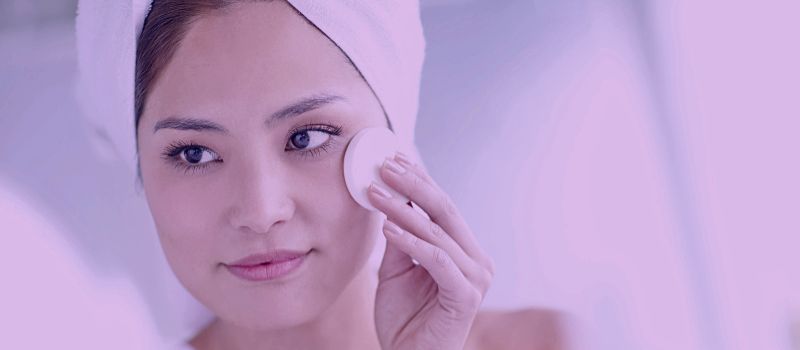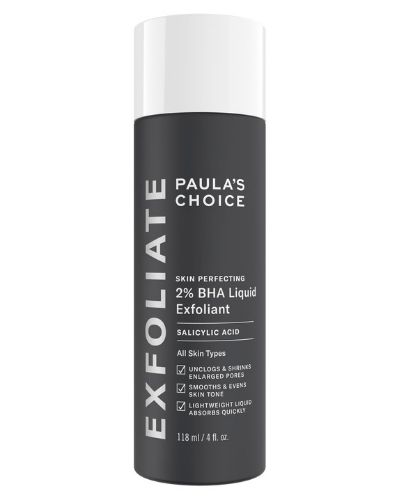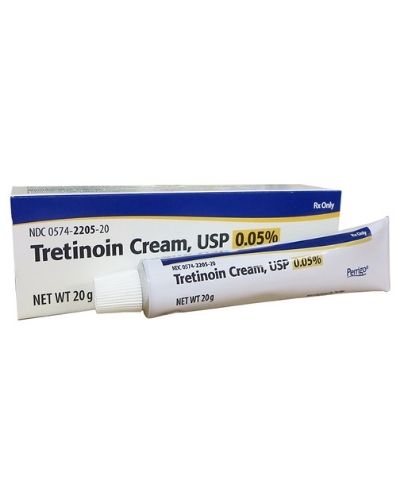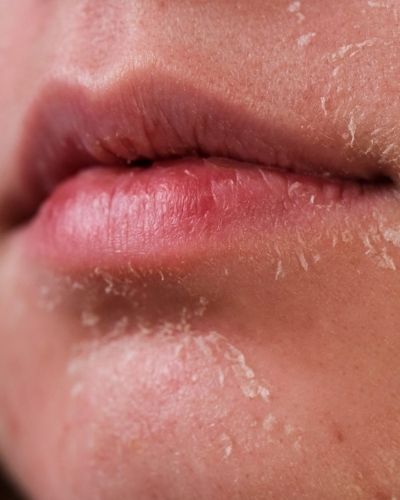There are so many ingredients in skincare products that can be mixed together to target certain skin concerns and maximize skin benefits.
However, if there is one combination that should never be introduced to the skin, it has to be the one we will talk about today.
So, to answer your question: no, you can’t use Paula’s Choice BHA with tretinoin unless you want to deal with some (potentially) pretty serious consequences.
But if you want to read more about the two products, how they work, and understand why you can’t use BHA with tretinoin in the same routine, continue reading.

How Does Paula’s Choice BHA Work?

Paula’s Choice 2% BHA Liquid Exfoliant is a gentle, hydrating toner that contains salicylic acid.
Salicylic acid is a BHA (beta hydroxy acid) and an oil-soluble ingredient that cuts through the superficial skin oil and travels deeper into the pores, where it dissolves the gunk made up of dead skin cells, white blood cells, oil, and other cellular debris that’s causing a stiff clog.
This will, in turn, allow for our natural oil to flow freely out of the pores instead of remaining stuck inside and causing skin concern such as blackheads and acne.
Salicylic acid is truly an amazing ingredient; however, the catch with it is that you have to continue using it to continue seeing results, as your skin is likely to come back to the same old if you stop using it for a longer period of time.
Some benefits of using salicylic acid include:
- Soothing inflammation on the skin.
- Cutting through the surface oil and deeply cleansing congested pores.
- Making the pores appear smaller and clearer.
- Clearing acne-breakouts.
- Dissolving blackheads.
- Soothing deeply inflamed cysts.
How Does Tretinoin Work?

Tretinoin, also known as all-trans retinoic acid, is an active form of vitamin A.
It is one of the most studied and research-backed ingredients and works incredibly well to fix various skin concerns.
Tretinoin works by speeding up cell turnover (the rate at which your skin produces new cells and sheds them from its surface.)
Therefore, after starting tretinoin, your skin cells will travel faster to the surface, purging clogs in the process and revealing a brighter, smoother, healthier, and more unified complexion.
Some of the main benefits of using tretinoin are:
- Decreased lines and wrinkles.
- Improved hyperpigmentation and discoloration.
- Refined texture.
- Decreased sun damage.
- Reduced acne and clear skin.
Risks of Combining BHA With Tretinoin

While your skin can benefit from both salicylic acid and tretinoin, you have to keep these two in separate routines.
Both ingredients have great skin benefits and can target multiple skin concerns at once; however, these can be terrible for the skin if mixed together.
Here are some potential side effects of using salicylic acid with tretinoin:
Over-exfoliation
Since both ingredients have exfoliating properties (although tretinoin works in a different way), using them together could easily lead to over-exfoliation, which is bad news for the skin.
Over-exfoliated skin has difficulty retaining moisture because the new, immature cells may give a glowy complexion, but they don’t have the optimal moisture-holding capacity as mature cells do, which is why moisture will evaporate easier.
Dryness and Irritation
When moisture evaporates from the skin easier, this will leave the skin dry and irritated.
The skin may try to compensate for the dryness by producing more and more oil, which will then lead to greasy skin and eventually more clogs and more breakouts.
This means that the skin’s function is out of whack, and the skin needs to heal and go back to normal function before it can deal with such a stubborn inflammatory condition, which is acne.
RELATED: How to Get Rid of Dry & Flaky Skin?
Damaged Skin Barrier
When the skin doesn’t function optimally, that means the skin’s barrier is damaged and impaired in normal function.
Damaged skin barrier typically manifests itself as being constantly irritated, red, and inflamed.
It often gets to the point where it will be painful to even wash your face with plain water due to the intense burning sensation.
Peeling and Flaking
And last but not least, combining salicylic acid and tretinoin will definitely lead to intense peeling and flaking, especially around the mouth.
Both ingredients (but especially tretinoin) cause initial peeling and shedding, which typically lasts for a few weeks until the skin gets used to the active ingredient.
However, mixing both ingredients in the same routine can intensify this occurrence and can sometimes trigger the skin to shed for a few days without stopping.
This was my personal experience after I mixed Paula’s Choice BHA Liquid Exfoliant with tretinoin back when I didn’t know any better.
I’ve since stopped using tretinoin because it didn’t work out for me, but the one time I mixed the two products led my skin into intense shedding for a few days.
I also experienced extremely dry and cracked skin, which is something I usually get after a chemical peel, and this occurrence was a clear indication I had over-exfoliated my skin.
RELATED: Is Tretinoin Good for Cystic Acne?
How to Use the Paula’s Choice BHA With Tretinoin?
If you still want the benefits of Paula’s Choice BHA but don’t want to give up using tretinoin, you can try using them in separate routines.
For example, one way to do this is to pause tretinoin for a couple of days and use Paula’s Choice BHA in the evening, followed by a moisturizer.
Another way to use them together is to apply Paula’s Choice BHA in the morning and then apply tretinoin the next evening, as this will give your skin more than 24 24-hour break from the active.
However, you should definitely proceed with caution, and in case your skin gets irritated (which is very likely), don’t try mixing them again until your skin gets properly used to tretinoin.
Additionally, you should also avoid mixing the two actives as soon as you start using tretinoin.
I’ve heard from people that have tried using Paula’s Choice BHA as soon as the initial tretinoin purge started in hopes the toner will help the purge subside faster.
However, this isn’t a great idea because your skin will probably be irritated during this period, so adding BHA for whatever reason will likely cause more issues than benefits.
BHA Alternatives You Can Use With Tretinoin
Combining salicylic acid and tretinoin can cause various side effects, including dryness, redness, peeling and flaking, and irritation.
Therefore, while you definitely want to avoid this skincare combo, there are other ingredients that you can combine with tretinoin to target multiple skin concerns without exacerbating acne.
Here are some acne-safe ingredients that you can use with tretinoin to boost results:
Niacinamide
Niacinamide, also known as Vitamin B3, is a powerhouse skincare ingredient renowned for its multi-faceted benefits.
It contributes to strengthening the skin’s barrier by boosting ceramide production, thereby improving skin resilience and hydration.
Additionally, niacinamide aids in reducing inflammation, minimizes the appearance of enlarged pores, and diminishes skin discolorations.
Its benefits make it an excellent adjunct to tretinoin, as it can mitigate some side effects from tretinoin, like dryness and irritation, improving overall skin health and enhancing tretinoin’s efficacy.
Azelaic Acid
Azelaic acid is a dicarboxylic acid that naturally occurs in grains like wheat, barley, and rye. It’s used in skincare due to its anti-inflammatory, antibacterial, and keratolytic properties, making it effective in treating a variety of skin conditions, including acne and rosacea.
The benefits of azelaic acid include reducing redness and inflammation, brightening the skin tone, and diminishing the appearance of skin blemishes.
When used in conjunction with tretinoin, azelaic acid can help mitigate some of the potential side effects, such as irritation and redness, while enhancing the acne-fighting capabilities of tretinoin. It can also help brighten the skin and improve its overall texture.
Hyaluronic Acid
Hyaluronic acid is a naturally occurring sugar molecule in our body that helps retain water and keep our tissues hydrated.
It is often utilized in skincare products due to its exceptional ability to bind and retain water molecules, thereby increasing skin hydration.
The benefits of hyaluronic acid include improved skin hydration, enhanced skin elasticity, and reduced appearance of wrinkles and fine lines.
Moreover, when used with tretinoin, it can help curb potential side effects such as dryness and peeling, providing a moisture boost to keep the skin balanced and healthy.
This combination can potentially enhance tretinoin’s effectiveness by maintaining optimal skin hydration levels, thus encouraging better absorption and efficacy.
Ceramides
Ceramides are naturally occurring lipids (fats) that form a critical component of the skin’s barrier, holding skin cells together and creating a protective layer to prevent moisture loss and guard against environmental irritants.
They play a vital role in maintaining skin hydration and overall skin health.
The benefits of ceramides include enhanced skin smoothness, hydration, and a significant reduction in skin irritations and sensitivity.
When paired with tretinoin, ceramides can help counteract potential side effects like dryness and irritation by reinforcing the skin’s natural barrier and enhancing moisture retention.
This results in a smoother, more balanced, and nourished complexion, thus promoting the optimal performance of tretinoin.
RELATED: Best Facial Serums For Textured Skin
Peptides
Peptides are chains of amino acids that serve as the building blocks of proteins, such as collagen and elastin, that are essential for maintaining the skin’s firmness and elasticity.
They act as signaling molecules, instructing your skin to repair itself, thereby tending to wrinkles, fine lines, and skin texture.
The benefits of peptides include stimulating collagen production for firmer, younger-looking skin and reducing inflammation.
When used with tretinoin, peptides can enhance its skin rejuvenating effects by boosting collagen production, thus helping to repair skin damage and improve overall skin health.
However, be mindful of combining peptides and tretinoin, as not all types of peptides go well with this anti-aging powerhouse.
Some types, like copper peptides, can potentially reduce tretinoin’s efficacy, while others, such as oligopeptides, can be a fantastic addition to your skincare routine.

My name is Simone and I am a certified skin specialist. I created this website to teach my readers how to take great care of their skin and I also like to occasionally share my honest opinions on skincare products I’ve tried. You can learn more about me here.
